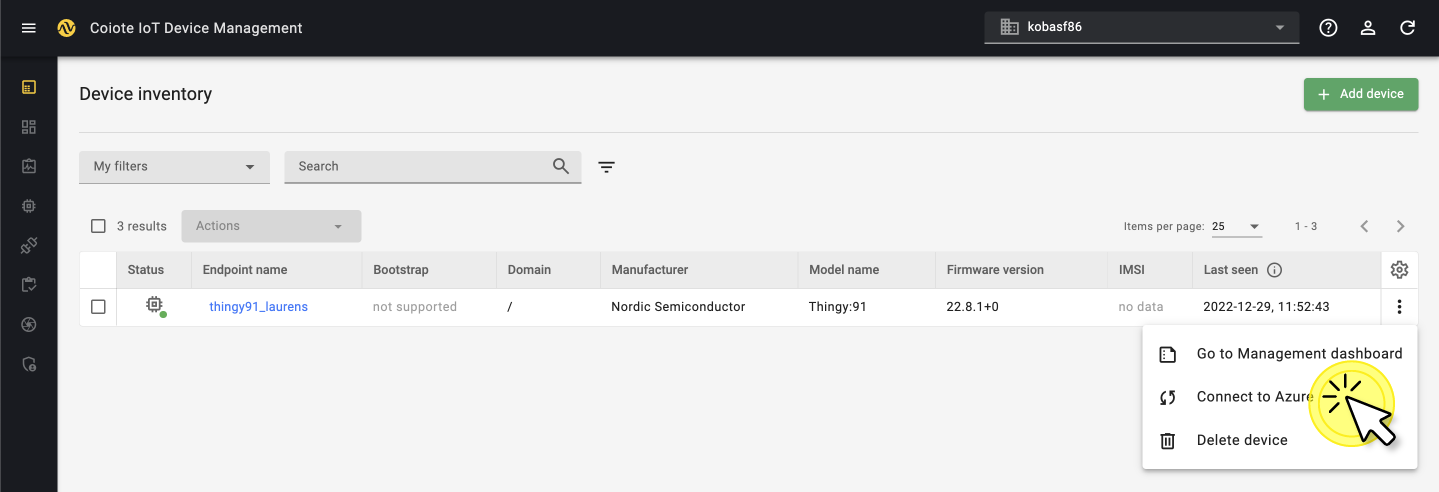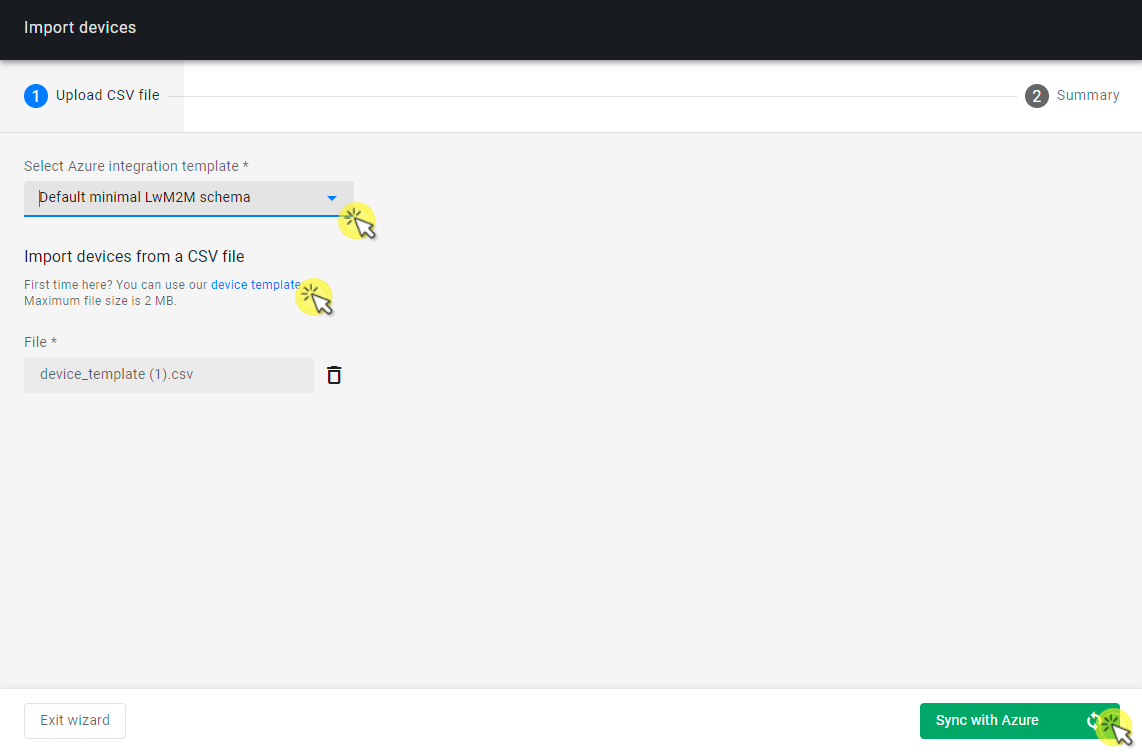Synchronize devices with Azure IoT Hub#
Importing devices to Coiote IoT DM and synchronizing them with Azure IoT Hub is a quick way to start using your Coiote IoT DM - Azure IoT Hub integration. The import operation will do two basic operations automatically:
- Create device entities in Coiote IoT DM with the credentials that you specified,
- Create the devices' "counterparts" within Azure IoT Hub and synchronize them with Coiote IoT DM.
Prerequisites#
- A connected Azure IoT Hub integration in the Hyperscaler Integration Center.
Option 1: Syncronize devices one by one#
In Coiote IoT DM, go to the Device inventory and search for the device you want to connect to Azure.
Click on the three dots and select the option Connect to Azure.
Select the minimal or the rich LwM2M schema (unless you created a custom LwM2M template).

Option 2: Import devices from CSV using a default integration template#
In the import process, you will need a list of devices that you want to import along with an integration template to be used by the Azure IoT Hub. To learn more about Azure integration templates, see the Configure integration templates section.
- In Coiote IoT DM, go to Administration -> Hyperscaler Integration Center.
- Make sure you have an integration connected in the Integration tab.
- Go to the Device list tab and click Import devices.
- In the Import devices wizard:
- From the Select template field, select one of two default integration templates:
- Default minimal LwM2M schema - a pre-defined template implementing a basic device data model.
- Default rich LwM2M schema - a pre-defined template implementing an extended device data model.
Note
Integration templates are crucial in the device import process. Optionally, you can create your custom device template and use it in importing. Check the instructions in the Configure integration templates section.
- In the Import devices from a CSV file section:

- If you already have a CSV file with devices for import, click Browse and select the file.
- If you don't have a CSV with devices for import yet, click the device template link to download an empty template that you can fill in with your data:
- EndpointName - provide endpoint name of your device.
- PSK_Identity_Key - provide a unique plain-text PSK identity key used for secure communication between the device and Coiote IoT DM.
- PSK_Key - provide a unique HEX-encoded PSK key used for secure communication between the device and Coiote IoT DM.
- Save the template and upload it using the Browse button and dialog window.
- Click Sync with Azure.
- From the Select template field, select one of two default integration templates:
- After a moment, the import operation should finish successfully.

- Now you can connect your physical devices to Coiote IoT DM using their credentials and the dedicated URL displayed after the successful device import.
What the import operation does#
Once the devices from the CSV template are imported into Coiote IoT DM, the following actions are performed:
- In Coiote IoT DM, device entities are created based on the credentials provided in the template. All such entities are visible in the Device list tab.
- In Coiote IoT DM, a dedicated integration group is automatically created (with the name built up by the
hyperscalercenterprefix and the template ID, e.g.618238c8bcafcb43b2911262). - In your Azure IoT hub, devices are created and ready for operation.
Check device error logs#
Logs may come helpful for diagnosing and troubleshooting issues with the communication between the three actors in the integration: the device, Coiote IoT DM, and Azure IoT Hub.
To see logs for your integrated devices:
-
Go to the single device view in Coiote IoT DM, from the left menu, select the Logs tile.
Info
The logs are only available in the previous version of Coiote IoT DM. Select Go to previous version in the top-right corner.

-
In the Logs panel, expand the view by clicking on More and configure the following:
- Store from level - select Use custom and set log level to DEBUG for 1 hour.
- Tags - select HYPERSCALERS

The communication logs will be displayed, allowing you to check, diagnose, or debug any issues.
Removing devices#
If a device is removed from Coiote IoT DM then it is also removed from IoT Hub, please note that if some communication error occurs during deletion then device must be removed manually from IoT Hub